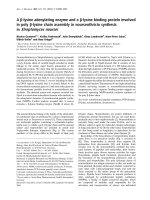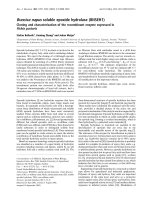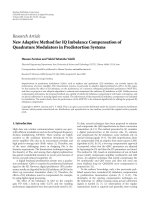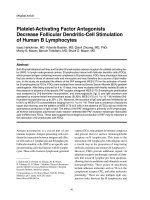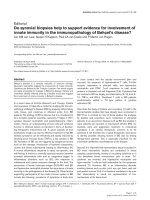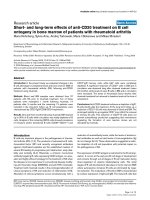Báo cáo y học: "Short reflex expirations (expiration reflexes) induced by mechanical stimulation of the trachea in anesthetized cats" ppt
Bạn đang xem bản rút gọn của tài liệu. Xem và tải ngay bản đầy đủ của tài liệu tại đây (473.16 KB, 9 trang )
BioMed Central
Page 1 of 9
(page number not for citation purposes)
Cough
Open Access
Research
Short reflex expirations (expiration reflexes) induced by
mechanical stimulation of the trachea in anesthetized cats
Ivan Poliacek*
1,2
, Melanie J Rose
1
, Lu Wen-Chi Corrie
1
, Cheng Wang
1
,
Jan Jakus
2
, Helena Barani
2
, Albert Stransky
2
, Hubert Polacek
3
,
Erika Halasova
4
and Donald C Bolser
1
Address:
1
Department of Physiological Sciences, College of Veterinary Medicine, University of Florida, PO box 100144, 1600 SW Archer Road,
Gainesville, Florida, 32610-0144, USA,
2
Department of Medical Biophysics, Jessenius Faculty of Medicine, Comenius University, Mala Hora 4,
037 54, Martin, Slovakia,
3
Clinic of Radiodiagnostics, Jessenius Faculty of Medicine, Comenius University, Martin, Slovakia and
4
Department of
Medical Biology, Jessenius Faculty of Medicine, Comenius University, Martin, Slovakia
Email: Ivan Poliacek* - ; Melanie J Rose - ; Lu Wen-Chi Corrie - ;
Cheng Wang - ; Jan Jakus - ; Helena Barani - ;
Albert Stransky - ; Hubert Polacek - ; Erika Halasova - ;
Donald C Bolser -
* Corresponding author
Abstract
Fifty spontaneously breathing pentobarbital-anesthetized cats were used to determine the
incidence rate and parameters of short reflex expirations induced by mechanical stimulation of the
tracheal mucosa (ERt). The mechanical stimuli evoked coughs; in addition, 67.6% of the stimulation
trials began with ERt. The expiration reflex mechanically induced from the glottis (ERg) was also
analyzed (99.5% incidence, p < 0.001 compared to the incidence of ERt). We found that the
amplitudes of abdominal, laryngeal abductor posterior cricoarytenoid, and laryngeal adductor
thyroarytenoid electromyograms (EMG) were significantly enhanced in ERg relative to ERt. Peak
intrathoracic pressure (esophageal or intra-pleural pressure) was higher during ERg than ERt. The
interval between the peak in EMG activity of the posterior cricoarytenoid muscle and that of the
EMG of abdominal muscles was lower in ERt compared to ERg. The duration of thyroarytenoid
EMG activity associated with ERt was shorter than that in ERg. All other temporal features of the
pattern of abdominal, posterior cricoarytenoid, and thyroarytenoid muscles EMGs were equivalent
in ERt and ERg.
In an additional 8 cats, the effect of codeine administered via the vertebral artery was tested.
Codeine, in a dose (0.03 mg/kg) that markedly suppressed cough did not significantly alter either
the incidence rate or magnitudes of ERt.
In the anesthetized cat the ERt induced by mechanical stimulation of the trachea was similar to the
ERg from the glottis. These two reflex responses differ substantially only in the frequency of
occurrence in response to mechanical stimulus and in the intensity of motor output.
Published: 28 April 2008
Cough 2008, 4:1 doi:10.1186/1745-9974-4-1
Received: 14 December 2007
Accepted: 28 April 2008
This article is available from: />© 2008 Poliacek et al; licensee BioMed Central Ltd.
This is an Open Access article distributed under the terms of the Creative Commons Attribution License ( />),
which permits unrestricted use, distribution, and reproduction in any medium, provided the original work is properly cited.
Cough 2008, 4:1 />Page 2 of 9
(page number not for citation purposes)
Background
Forceful expirations are substantial part of airway defense.
They arise particularly during tracheal and laryngeal
coughs, sneeze, and the expiration reflex. Basic character-
istics of these behaviors are known (see e.g. [1,2]) includ-
ing the complex movement of the larynx [3-5].
The expiration reflex (ER) is characterized by a single and
short expulsion without a preceding inspiration. ER is reg-
ularly induced from the glottis (ERg) by mechanical stim-
ulation. Its function is to expel foreign particles from the
upper airways by fast expiratory airflows [1,6]. The reflex
represents a fundamental aspiration prevention mecha-
nism [7] and is significant particularly in gastro-esopha-
geal reflux [8], in laryngopharyngeal reflux [9,10], and
under other conditions when a risk of the aspiration is
markedly increased.
Several authors have observed short reflex expirations that
were not preceded by an inspiration during stimulation in
the trachea (ERt) of cats [11,12], dogs [13], and humans
[14]. Others reported that from 1/3 [15] up to 60% ([16],
also personal communication) of repetitive cough epi-
sodes induced in lower airways of anesthetized cats began
with expulsion. The presence of an ER in response to
mechanical stimulation of the trachea represents an
important component of airway defense related to aspira-
tion prevention. This behavior presumably is a "backup"
to ER from the larynx and serves to eject foreign material
from the trachea when the laryngeal ER (ERg) has failed to
prevent aspiration. The extent to which these tracheal
expirations (ERt) represent unique behaviors induced
from stimulation of the lower airways is unknown. Some
authors concluded that the ERt and ERg are the same
behavior and they used the term "expiration reflex" for
both of them [7,15]. However, this conclusion is based
only on qualitative inspection of the motor patterns.
Additional evidence is required to support the conclusion
that ERt and ERg are identical reflexes.
The purpose of this study was to quantitatively examine
multiple ERt induced by mechanical stimulation of the
tracheobronchial airways in cats, to determine their inci-
dence rate, and to compare their mechanical and electro-
physiological characteristics with ERg. We hypothesized
that ERt and ERg may represent essentially the same reflex
behavior elicited from two different regions of the air-
ways.
Methods
All procedures were performed in accordance with the
NIH Guide for the Care and Use of Laboratory Animals,
the Animal Welfare Guidelines of the University of Flor-
ida, the ethical rules, and the legislation of USA and Slo-
vakia. The protocols were approved by Ethics committee
of Jessenius Faculty of Medicine Commenius University
and the State veterinary administration of Slovakia (N°
5492/1999-500 and 6708/03-220) or by the University of
Florida Institutional Animal Care and Use Committee
(N° 8663-2004).
Experiments were performed on 58 spontaneously
breathing adult cats. Fifty cats (3.44 ± 0.11 kg), 42 of them
females, were used to determine an incidence rate and
behavioral characteristics of the ERt. Eight cats were tested
for the effect of intravertebral administration of codeine
on ERt. The animals were anesthetized with sodium
pentobarbital (35–40 mg/kg i.p. or i.v.). Supplementary
doses were administered (1–3 mg/kg, i.v.) as needed.
Atropine (0.1 – 0.2 mg/kg, i.v.) was given at the beginning
of the experiment to reduce secretions. Seventeen out of
50 animals were also used in brainstem recording proto-
cols and received hydrocortisone (9 mg/kg) to prevent
brain edema. The trachea, femoral artery and vein were
cannulated. An esophageal balloon was used for measur-
ing intrathoracic pressure alterations in 33 cats and a pleu-
ral cannula was placed in 17 animals. Arterial blood
pressure, end-tidal CO
2
, and body temperature were con-
tinuously monitored. Body temperature was maintained
at 37.5 ± 0.5°C by a heating lamp and a pad. Arterial
blood samples were periodically removed for blood gas
analysis. The animals breathed air mixtures that were
enriched by oxygen (25 – 60%) as required to maintain
arterial pO
2
values above 13 kPa (100 mm Hg).
In 8 cats a cannula was introduced into the left brachial
artery and the tip was positioned near the origin of the
vertebral artery. All other branches of the subclavian artery
in the region were clamped so the codeine (a single dose
of 0.03 mg/kg) was delivered directly to the brainstem cir-
culation.
Electromyograms (EMG) of respiratory muscles were
recorded with bipolar insulated fine wire electrodes. We
recorded EMGs from the expiratory abdominal muscles
(ABD) transversus abdominis, rectus abdominis or exter-
nal oblique, from the inspiratory parasternal muscles
(PS), in 17 animals and in an additional 8 "codeine" cats
alternatively from the diaphragm (DIA), in 42 animals
from the inspiratory laryngeal posterior cricoarytoneid
muscle (PCA), and in 39 cats from the expiratory laryn-
geal thyroarytenoid muscle (ThAr). The PS electrodes were
placed at T3 proximal to the sternum. The DIA electrodes
were introduced into the crural diaphragm. Transversus
abdominis and rectus abdominis (or external oblique)
electrodes were placed 3–4, respectively 1 cm lateral to the
linea alba. The PCA electrodes were inserted along the
dorsal surface of the arytenoid cartilage using its dorsal
edge as a visual cue after gently elevating the larynx. The
ThAr electrodes were inserted directly through the crico-
Cough 2008, 4:1 />Page 3 of 9
(page number not for citation purposes)
thyroid membrane. Proper placement of each set of elec-
trodes was confirmed by the appropriate inspiratory or
expiratory phased activity during breathing and other res-
piratory events as well as by visual inspection.
Animals (except the 8 codeine cats) were placed prone in
a stereotaxic frame and the dorsal surface of medulla was
exposed by an occipital craniotomy for later interventions
in the brainstem under another protocol. The medullary
surface was covered by warm paraffin oil.
Mechanical stimulation of the intrathoracic trachea
(between the edge of tracheal cannula and the carina) was
performed with a thin polyethylene catheter (diameter 0.5
– 1.0 mm) or nylon fiber (diameter 0.2 – 0.5 mm) for the
period of 5–20 s. Six to 18 stimulation trials (11.2 trials in
an average) were conducted without any additional inter-
vention (the time interval between stimulation trials was
approximately 1 minute). The stimulations elicited ERt
and single or repetitive coughs (Fig. 1). We used a
mechanical stimulus on the glottis with the thin nylon
fiber (diameter 0.2 mm) in order to induce ERg. In an
additional 8 codeine cats, 20 – 30 mechanical stimulation
trials were conducted to establish a stable cough baseline.
Then 5 control pre-codeine stimulus trials were applied
during the period of 5 min, followed by 5 stimulus trials
after the intra-vertebral administration of the codeine
(0.03 mg/kg).
The ERt from the trachea (Fig. 1, 2 and 3) and ERg from
the glottis were both defined as a brief short burst of ABD
electrical activity with positive swing of esophageal or
pleural pressure without a preceding inspiration. The
response induced in the inspiratory phase of breathing
regularly and immediately terminated inspiration. No
coactivation of inspiratory (PS or DIA) and expiratory
activity (ABD) was observed either in ERt (Fig. 2) or in ERg
[4,5]. Cough was defined as a coordinated inspiratory-
expiratory sequence manifest as a large burst of inspira-
tory EMG activity immediately followed by a burst of
expiratory ABD activity with an inspiratory-expiratory
waveform of intrathoracic pressure (Fig. 1). These criteria
The reflex responses to the mechanical stimulation (stim) in the tracheaFigure 1
The reflex responses to the mechanical stimulation (stim) in the trachea. Two quiet breaths (slight inspiratory
increase in the records of laryngeal abductor posterior cricoarytenoid – PCA and parasternal muscles – PS EMG moving aver-
ages with a depression in esophageal pressure – EP) followed by a short reflex expiration (ERt) at the beginning of stimulation
(steep elevations in EMG moving averages of laryngeal adductor thyroarytenoid muscle – ThAr, PCA, and abdominal muscles –
ABD, as well as in EP). The ERt was then followed by 3 coughs in which the expulsions caused slight elevations of blood pres-
sure (BP). Moderate post-inspiratory activity was present at the inspiratory-expiratory transition of quiet breathing in ThAr.
The ERt was markedly shorter compared to the cough expulsions (see ABD and EP) leading to the lower amplitude of EP com-
pared to that in coughs, although the amplitudes of ABD EMG moving averages remained comparable.
Cough 2008, 4:1 />Page 4 of 9
(page number not for citation purposes)
separated ERt or ERg from cough and also from other air-
way defensive behaviors such as augmented breath and
aspiration reflex.
All EMGs were amplified, filtered (300 – 5000 Hz), recti-
fied, and integrated (time constant 50 ms). We analyzed
for both the ERt and ERg: (1) the number and the inci-
dence rate, (2) the amplitudes of ABD, PCA and ThAr
EMG moving averages, (3) the peak of esophageal or pleu-
ral pressure, (4) the duration and time correlations of
PCA, ThAr, and ABD activities. Magnitudes of the ABD,
PCA, and ThAr moving averages were normalized to the
strongest tracheal cough reflex. The characteristics of ERt
and ERg in cats treated with hydrocortisone and chest wall
surgery (in order to insert pleural cannula, 17 cats) were
similar to those measurements taken from animals with-
out such interventions (33 cats). Thus, the final analysis
was performed on all these 50 cats.
Results are expressed as a mean values ± SEM. Incidence
rate of ERt and ERg, their occurrence in trials that began
during inspiration and expiration, the number of cats
selected for analysis of ERt/ERg parameters (ERt or ERg ≥
0.2 kPa (> 1.5 mm Hg)), and the number of animals with
analyzed laryngeal muscles EMGs were processed with the
Fisher's exact test. The parameters of ERt and ERg were
compared using unpaired t-test, Welch corrected unpaired
t-test, and Mann-Whitney test (Table 1). The paired t-test
was used to compare ERt ABD EMG amplitudes in
codeine-treated cats. The differences of variables were
considered significant at p < 0.05.
Results
We conducted 562 tracheal stimulation trials in 50 ani-
mals, 326 of them began in the expiratory period of
breathing (58%), 236 in inspiration (42%). The stimula-
tion induced cough (Fig. 1) and during 380 stimulation
trials also ERt (67.6%, Fig. 1, 2 and 3). ERt typically
appeared at the beginning or very early stage of the tra-
cheal stimulation (Fig. 1, 2 and 3). For 380 stimulation
trials with ERt, 263 trials began in expiration (69.2%),
117 in inspiration (30.8%). No ERt were detected in 182
trials (32.4%); 117 of these non-responding stimulations
began during inspiration (64.3%,), 65 trials in expiration
(35.7%). ERt was significantly more elicitable in expira-
tion (p < 0.001, Fisher's test).
We selected 28 animals with multiple ERt in which the
magnitude of the expulsion reached at least 0.2 kPa (120
ERt, 99 of them induced in expiration, 21 in inspiration)
for further analysis. The ABD EMG of 34 out of 120 ERt
consisted of two bursts in close succession; another 26
Mechanical stimulation of the trachea (stim) with short reflex expiration (ERt) during the inspiratory period of breathingFigure 2
Mechanical stimulation of the trachea (stim) with short reflex expiration (ERt) during the inspiratory period of
breathing. The stimulation immediately terminated an inspiration (rapid suppression of PCA and PS) and induced the ERt
(abrupt activation of ThAr, PCA and ABD). Two much weaker ERt were detectable in the record of ABD, before the initial
cough inspiration began (activation of PCA at the end of the record). See Fig. 1 for abbreviations.
Cough 2008, 4:1 />Page 5 of 9
(page number not for citation purposes)
were multiple burst complexes. Only the largest compo-
nent of these multi-burst responses was measured. The
characteristics of the PCA EMG were examined during 96
ERt in 23 cats and that of ThAr during 86 ERt in 20 cats
(Table 1). The PCA EMG responded with a short burst of
activity that slightly preceded the ABD activity. The ThAr
was activated even earlier than the PCA and then sup-
pressed while ABD EMG activity reached its peak (Fig. 3).
However, a prolongation of ThAr activity during ERt was
recorded in 62 out of 86 ERt; a second prolonged activity
of ThAr appeared after the ABD burst (Table 1, Fig. 1, 2
and 3).
Glottal stimuli applied in 31 animals produced ERg
99.5% of the time (426 out of 428 stimulations, 279 dur-
ing expiration and 149 during inspiration). The animals
with multiple ERg, pressure amplitudes of which reached
at least 0.2 kPa, were included in further analysis (211 ERg
in 27 cats, 150 of them in expiration and 61 in inspira-
tion; Table 1). The features of laryngeal muscle activities
were measured on 176 ERg in 22 cats (Table 1).
No significant differences between the characteristics of
ERt or ERg that were induced in expiration vs. inspiration
were found.
The intra-vertebral administration of codeine (0.03 mg/
kg) did not affect the incidence rate of ERt (23/40 vs. 21/
40 in control, p > 0.81, Fisher's test) and their ABD EMG
amplitudes (5 ± 1% vs. 10 ± 4% in control, p > 0.32,
paired t-test) compared to the ERt in pre-codeine control.
This intervention reduced the number of tracheal coughs
by 73% (p < 0.01, paired t-test) and cough ABD EMG
amplitudes from 46 ± 8% to 9 ± 4% (p < 0.01, paired t-
test).
Discussion
The major finding of this study was that quantitative anal-
ysis of mechanically induced ERt and ERg revealed a high
degree of similarity between these two behaviors.
The patterns of ABD, PCA, and ThAr were similar during
both ERt and ERg. Laryngeal adductor ThAr was activated
first, then PCA and ABD followed. During the maximum
ABD bursting suppression of ThAr was detected that was
frequently followed by another prolonged burst of ThAr
activity. We propose that such patterns in activation of
ThAr, PCA, and ABD may represent 3 phases of laryngeal
movement during ERt, which are the compressive, expulsive,
and subsequent constriction phase analogously to those
found in ERg [4,5,17].
Motor pattern of short reflex expiration (ERt) induced by mechanical stimulation of the trachea (stim)Figure 3
Motor pattern of short reflex expiration (ERt) induced by mechanical stimulation of the trachea (stim). See Fig.
1 for abbreviations.
Cough 2008, 4:1 />Page 6 of 9
(page number not for citation purposes)
We found higher amplitudes of ABD, PCA, and ThAr EMG
moving averages, as well as higher pressure amplitudes in
ERg than those in ERt. The larynx is considered a very sen-
sitive area with a high density of receptors [18,19]. Laryn-
geal abductors and adductors were more vigorously
activated during the ERg and cough from the larynx, com-
pared to cough from the tracheal region [4]. As such,
stronger activation of laryngeal and abdominal motor
outputs might arise with stimulation of the larynx. Dis-
tinct sites of stimulation (glottis vs. trachea) could also
account for the longer duration of ThAr activity and the
earlier PCA maximum in ERg than in ERt (Table 1).
The frequency of occurrence of ERt was significantly lower
(67.6%) in our tracheal stimulation trials than that of
ERg. Tomori and Stransky [12] mechanically induced
expiratory responses from the glottis, subglottal, tracheal,
and nasal mucosa in anesthetized cats. They also saw a
higher incidence rate of ERg (85%) than that of ERt
(50%). However, the pressure amplitudes were higher in
their study compared with our results, particularly in the
case of ERt (1.2 kPa vs. our 0.49 kPa). The experimental
preparations could account for the differences in results
between the two studies, such as craniotomy on our cats
and different patterns of stimulation (brief tactile tracheal
stimuli vs. the continuous stimulation in present experi-
ments). Tatar et al. [15] also indicated a more frequent
occurrence of ERg compared to ERt in cats and rabbits.
The ERt appeared more frequently at the beginning of
stimulations that started during the expiratory period of
breathing (see results). This is in line with vigorous
expression of ERg when stimuli were delivered during
expiration, particularly at the beginning of an expiratory
period [20,21]. We also saw a higher incidence rate of ERg
with pressure amplitudes at least 0.2 kPa in expiration
than those in inspiration (p < 0.02, Fisher's test). How-
ever, we did not find any significant differences in the
parameters of ERt (and also ERg) that were induced dur-
ing inspiration vs. those ERt (ERg) in expiration. We have
to point out that the analyzed ERt (ERg) in inspiration
were the strongest responses obtained in the phase
(assuming the criterion of at least 0.2 kPa of pressure
amplitude).
Table 1: The parameters of short reflex expirations induced by mechanical stimulation of the trachea (ERt) and expiration reflexes
from the glottis (ERg).
ERt ERg p (test)
Number of cats 50 31
Excitability (responses/trials) 67.6% 99.5% < 0.001 (F)
Cats with several ERt/ERg ≥ 0.2 kPa 28 (out of 50) 27 (out of 31) < 0.01 (F)
Duration of ABD 63 ± 3 ms 70 ± 3 ms NS (t)
T (onset of ABD – ABD peak) 36 ± 3 ms 39 ± 2 ms NS (t)
Relative amplitude of ABD 36 ± 4% 60 ± 9% < 0.02 (W)
Expiatory pressure amplitude 0.49 ± 0.04 kPa 1.02 ± 0.16 kPa < 0.01 (W)
Number of cats – PCA 23 22 NS (F)
T (onset of PCA – ABD peak) 52 ± 3 ms 61 ± 4 ms NS (t)
T (peak of PCA – ABD peak) 14 ± 2 ms 25 ± 4 ms < 0.02 (W)
T (ABD peak – offset of PCA) 24 ± 3 ms 18 ± 6 ms NS (W)
Relative amplitude of PCA 67 ± 12% 137 ± 23% < 0.001 (M)
Number of cats – ThAr 20 22 NS (F)
T (onset of ThAr – ABD peak) 77 ± 4 ms 74 ± 6 ms NS (W)
T (peak of ThAr – ABD peak) 44 ± 3 ms 43 ± 3 ms NS (t)
T (ABD peak – minimum of ThAr) 7 ± 4 ms 21 ± 8 ms NS (W)
T (ABD peak – 2
nd
peak of ThAr) 140 ± 20 ms 130 ± 10 ms NS (W)
T (ABD peak – offset of ThAr) 440 ± 40 ms 730 ± 60 ms < 0.001 (W)
Relative amplitude of 1
st
ThAr peak 83 ± 10% 385 ± 77% < 0.001 (W)
Relative amplitude of 2
nd
ThAr peak 85 ± 20% 311 ± 70% < 0.01 (W)
ABD, PCA, and ThAr, EMG activities of abdominal, posterior cricoarytenoid, and thyroarytenoid muscles during ERt or ERg; T (onset of ABD –
ABD peak), the time interval from the beginning of the burst of ABD to the moment when the maximum of the moving average was reached
(amplitude of ABD moving average); other time intervals (T) were measured as described in the table; p (test), the level of statistical significance and
in brackets the appropriate test used; NS, non-significant (p > 0.05); F, Fisher's test; t, unpaired t-test; W, Welch corrected unpaired t-test; M,
Mann-Whitney test.
Cough 2008, 4:1 />Page 7 of 9
(page number not for citation purposes)
ERt, as well as the ERg, differ substantially from cough. As
we stated in the results, ERt appeared as a single (Fig. 1) or
sometimes as a few bursts (Fig. 2) just at the beginning of
tracheal stimulation. The response was induced presuma-
bly due to an immediate contact of the stimulation device
with the tracheal mucosa and before the threshold for the
cough response was achieved. ERg can occur repeatedly in
response to mechanical stimulation of the larynx [1], but
ERt has never been reported to occur repetitively in
response to mechanical stimulation of the tracheal-bron-
chial region [7]. Vovk et al. [22] also found a low inci-
dence rate of repeated ER in humans exposed to irritant
aerosols, particularly when compared with the number of
coughs. We did not quantify the number of coughs in our
stimulation trials. However, the cough number was typi-
cally higher than the number of ERt (Fig. 1). It is com-
monly accepted that cough is the primary (and most
frequent) response from the tracheal area and that the ER
is preferentially (and more frequently) induced from the
larynx [1,5,7]. ERt in our study were never detected after
the beginning of the initial cough inspiration. This obser-
vation also suggests that the ERt has a shorter latency for
onset relative to coughing. The latency of cough response
is typically several hundred ms [23,24], for ERg it is about
30 ms [12,25]. The laryngeal muscles are activated even
earlier (Table 1), which corresponds to the very short
latencies of responses detected in laryngeal motor output
following the superior laryngeal nerve stimulation
[26,27].
The motor pattern as well as a function of cough and ER
differ significantly [1,5,7]. Cough is an inspiratory-expira-
tory behavior (Fig. 1) [1,5,7]. EMG activities of inspiratory
and expiratory pump muscles were coactivated during the
inspiratory phase of cough and at the inspiratory-expira-
tory transition (pre-expulsive ABD activity) [28]. How-
ever, similar to ERg [17,20], when we induced the ERt in
the inspiratory period of breathing the inspiration was
immediately terminated and the expiratory response fol-
lowed after a short delay (Fig. 2). The ABD activity in
cough is substantially longer and stronger (Table 1; Fig. 1)
than that in ERt or ERg (see also [1,4,12]). Shorter expul-
sive phase durations and lower airflows of ER than those
of cough expulsions were reported after capsaicin chal-
lenge on humans [22]. We documented that the activa-
tion of the laryngeal muscles is also prolonged during
cough relative the ERg [4]. Moreover, there is a sequential
and biphasic activation and inhibition of laryngeal abduc-
tors and adductors in cough [4,5,29]. During ERt (Fig. 1,
2 and 3) or ERg [4,5], only the adductor activation
presents as a biphasic response; the PCA is activated in a
single short burst.
The ERt and ERg share other important characteristics dis-
tinct from those of coughing [7,15]. ERt/ERg depend on
lung capacity, particularly when they occur during the
expiratory period of the respiratory cycle. As such, there is
strong positive correlation between lung inflation and
pressure amplitudes of ER [30-32]. No such clear relation-
ship was found for cough [31,32]. The effects of general
anesthesia on cough and ERt/ERg also differ substantially.
Increased anesthetic levels have a more pronounced sup-
pressive impact on tracheal cough than on the ER [1,11].
The proportion of ERt to coughs was increased in anesthe-
tized cats compared with awake animals [15]. Although
the authors did not specifically identify ERt in their paper,
inspection of May and Widdicombe [33] data suggests
that morphine inhibited cough more than mechanically
induced ERt. Similar findings were reported for ERg after
the administration of codeine [1]. However, the effect of
codeine on ERt has not been reported previously. We
found that the codeine, a potent cough inhibitor in anes-
thetized cats [34], had little suppressive effect on ERt. As
such, there is no difference in the response of ERt and ERg
to central antitussives and this finding differs markedly
from the response of cough to these drugs.
Vovk et al. [22] analyzed cough and ER induced by capsa-
icin challenge in healthy awake humans. The authors dis-
tinguished repetitive ER and repetitive cough expulsions
(successive cough expirations), which were associated
with a single initial cough inspiration and termed this
phenomenon re-acceleration of expulsive airflow. Widdi-
combe and Fontana [7] discussed frequent "cough" pat-
terns containing individual and repetitive coughs (with
single or multiple expulsions) and eventually ERt/ERg.
Multiple (divided) expulsions with intermittent flow
might create more turbulent airflow and thus more effi-
cient shear forces along the walls of the lower airways than
the continuous airflow of a single expiration. The rate of
occurrence of such multiple cough expulsions in cough
animal models, particularly in the cat, is unknown; how-
ever, this number is low in accord with our own as well as
the observations of others [1]. Because subsequent cough
expulsions are consistent with the definition of ER, the
nomenclature of ER (also in accord with [7,22]) should be
re-examined. We propose to characterize the ER as a fam-
ily of behaviors (ERt and ERg) that: a) are short in dura-
tion (typically shorter compared to cough expulsion), and
b) nonrhythmic (without cyclic – rhythmic feature typical
for cough) [35] expiratory responses consisting of com-
pression and expulsion, which are not dependent on a
preceding inspiration. The ERt/ERg are likely produced
and controlled by different mechanisms than the expul-
sions in cough [5,7,22,35]. Distinct neuronal circuitries
generating the central motor patterns of the cough [36]
and ER [37] have already been proposed.
Cough 2008, 4:1 />Page 8 of 9
(page number not for citation purposes)
Conclusion
Our quantitative analyses as well as the reports of others
on the ERt and ERg vs. cough suggest that (1) ERt should
be considered a different reflex response from cough and
(2) ERt and ERg may represent the same defensive reflex,
which has a different frequency of occurrence and inten-
sity when induced from two distinct areas of the airways.
List of abbreviations
ABD: Abdominal muscles; DIA: Diaphragm; EMG: Elec-
tromyogram (electromyographic); ER: Expiration reflex;
ERg: Expiration reflex from the glottis or larynx; ERt: Short
reflex expiration (ER from the trachea); PCA: Posterior cri-
coarytenoid muscle; PS: Parasternal muscles; ThAr: Thy-
roarytenoid muscle.
Competing interests
The authors declare that they have no competing interests.
Authors' contributions
All authors have met criteria for an authorship of the arti-
cle. IP assembled the study, participated on the experi-
mental design, carried out experiments, analyzed data,
and drafted the manuscript; MJR carried out experiments,
contributed to the recording and processing of data, and
analyzed "codeine" data; LWChC carried out experiments,
contributed to the final analysis of data and to the manu-
script; ChW performed experiments and contributed to
the recording and processing procedures; JJ designed and
performed experiments, contributed to the manuscript;
HB performed experiments and carried out recording and
processing of data; AS participated on experimental
design and on the draft of manuscript; HP participated on
experimental design and data analysis; EH performed
experiments and contributed to the manuscript; DCB
designed and coordinated experiments, participated on
final analysis and on the draft of the manuscript. All
authors have read and approved the final manuscript.
Acknowledgements
This study was supported by grant No. 1/2274/05 (VEGA) from the Grant
Agency for Science of the Slovak Republic (J. Jakus) and National Heart,
Lung, and Blood Institute Grant HL-70125 (D.C. Bolser)
References
1. Korpas J, Tomori Z: Cough and other respiratory reflexes Basel: Karger
S; 1979.
2. Fontana GA: Motor Mechanisms and the Mechanics of Cough.
In Cough: Causes, Mechanisms and Therapy Edited by: Chung KF, Wid-
dicombe JG, Boushey HA. Blackwell; 2003:193-205.
3. Shiba K, Satoh I, Kobayashi N, Hayashi F: Multifunctional laryngeal
motoneurons: an intracellular study in the cats. J Neurosci
1999, 19(7):2711-2727.
4. Poliacek I, Stransky A, Jakus J, Barani H, Tomori Z, Halasova E: Activ-
ity of the Laryngeal Abductor and Adductor Muscles during
Cough, Expiration and Aspiration Reflexes in Cats. Physiol Res
2003, 52:749-762.
5. Jakus J, Tomori Z, Stransky A: Neuronal Determinants of Breathing
Coughing and Related Motor Behaviours: Basics of Nervous Control and
Reflex Mechanisms Martin: Wist; 2004.
6. Korpas J: Expiration reflex from the vocal folds. Physiol Bohe-
moslov 1972, 21(6):671-675.
7. Widdicombe J, Fontana G: Cough: what's in a name? Eur Respir J
2006, 28(1):10-15.
8. Ing AJ: Cough and gastro-oesophageal reflux disease. Pulm
Pharmacol Ther 2004, 17:403-413.
9. Broussard DL, Altschuler SM: Central integration of swallow and
airway-protective reflexes. Am J Med 2000, 108(Suppl
4a):62S-67S.
10. Medda BK, Kern M, Ren J, Xie P, Ulualp SO, Lang IM, Shaker R: Rel-
ative contribution of various airway protective mechanisms
to prevention of aspiration during swallowing. Am J Phys Med
Rehabil 2003, 82(5):370-373.
11. Widdicombe J: Respiratory reflexes from the trachea and
bronchi of the cat. J Physiol 1954, 123(1):55-70.
12. Tomori Z, Stransky A: Electroneurographic and pneumotacho-
graphic analysis of the expiration reflex. Physiol Bohemoslov
1973, 22:589-601.
13. Sullivan CE, Kozar LF, Murphy E, Phillipson EA: Arousal, ventila-
tory, and airway responses to bronchopulmonary stimula-
tion in sleeping dogs. J Appl Physiol (Respir Environ Exercise Physiol)
1979, 47(1):17-25.
14. Nishino T, Hiraga K, Yokokawa N: Laryngeal and respiratory
responses to tracheal irritation at different depth of enflu-
rane anesthesia in humans. Anesthesiology 1990, 73:46-51.
15. Tatar M, Hanacek J, Widdicombe J: The expiration reflex from
the trachea and bronchi. Eur Respir J 2008, 31:385-390.
16. Hanacek J, Tatar M: Does cough start with a deep inspiration?
Lessons from animal experiments. In 4th International Sympo-
sium on Cough. 29th June – 1st July; London Edited by: Chung KF, Wid-
dicombe JG. Imperial College; 2006:13-14.
17. Stransky A, Tomori Z: Changes in laryngeal motoneurone
activity and in laryngeal calibre during the expiration reflex.
Physiol Bohemoslov 1979, 28(4):365-373.
18. Sant'Ambrogio G, Mathew OP, Fisher JT, Sant'Ambrogio FB: Laryn-
geal receptors responding to transmural pressure, airflow
and local muscle activity. Respir Physiol 1983, 54:317-330.
19. Sant'Ambrogio G, Sant'Ambrogio FB: Role of laryngeal afferents
in cough. Pulm Pharmacol 1996, 9(5–6):309-314.
20. Nishino T, Honda Y: Time-dependent responses of expiration
reflex in cats. J Appl Physiol 1986, 61(2):430-435.
21. Korpas J, Jakus J: The expiration reflex from the vocal folds.
Acta Physiol Hung 2000, 87(3):201-215.
22. Vovk A, Bolser DC, Hey JA, Danzig M, Vickroy T, Berry R, Martin AD,
Davenport PW: Capsaicin exposure elicits complex airway
defensive motor patterns in normal humans in a concentra-
tion-dependent manner. Pulm Pharmacol Ther 2007,
20(4):423-432.
23. Engelhorn R, Weller E: Action potentials of respiration-syn-
chronous discharged neurons of the medulla oblongata dur-
ing coughing. Pflugers Arch 1961, 273:614-635.
24. Addington WR, Stephens RE, Widdicombe JG, Ockey RR, Anderson
JW, Miller SP: Electrophysiologic latency to the external
obliques of the laryngeal cough expiration reflex in humans.
Am J Physiol Gastrointest Liver Physiol 2003, 284:G933-G939.
25. Bongianni F, Corda M, Fontana G, Pantaleo T: Influences of supe-
rior laryngeal afferent stimulation on expiratory activity in
cats. J Appl Physiol 1988, 65(1):385-392.
26. Barillot JC, Bianchi AL, Gogan P: Laryngeal respiratory motone-
urones: morphology and electrophysiological evidence of
separate sites for excitatory and inhibitory synaptic inputs.
Neurosci Lett 1984, 47(2):107-112.
27. Ambalavanar R, Purcell L, Miranda M, Evans F, Ludlow CL: Selective
suppression of late laryngeal adductor responses by N-
methyl-D-aspartate receptor blockade in the cat. J Neurophys-
iol 2002, 87:1252-1262.
28. Bolser DC, Reier PJ, Davenport PW: Responses of the anterola-
teral abdominal muscles during cough and expiratory
threshold loading in the cat. J Appl Physiol 2000, 88:1207-1214.
29. Sant'Ambrogio G, Kuna ST, Vanoye CR, Sant'Ambrogio FB: Activa-
tion of intrinsic laryngeal muscles during cough. Am J Respir
Crit Care Med 1997, 155:637-641.
30. Hanacek J, Korpas J: Modification of the intensity of the expira-
tion reflex during short-term inflation of the lungs in rabbits.
Physiol Bohemoslov 1982, 31(2):169-174.
Publish with BioMed Central and every
scientist can read your work free of charge
"BioMed Central will be the most significant development for
disseminating the results of biomedical researc h in our lifetime."
Sir Paul Nurse, Cancer Research UK
Your research papers will be:
available free of charge to the entire biomedical community
peer reviewed and published immediately upon acceptance
cited in PubMed and archived on PubMed Central
yours — you keep the copyright
Submit your manuscript here:
/>BioMedcentral
Cough 2008, 4:1 />Page 9 of 9
(page number not for citation purposes)
31. Nishino T, Sugimori K, Hiraga K, Honda Y: Influence of CPAP on
reflex responses to tracheal irritation in anesthetized
humans. J Appl Physiol 1989, 67(3):954-958.
32. Hanacek J, Tatar M, Widdicombe J: Regulation of cough by sec-
ondary sensory inputs. Respir Physiol Neurobiol 2006,
152(3):282-297.
33. May AJ, Widdicombe JG: Depression of the cough reflex by
pentobarbitone and some opium derivatives. Brit J Pharmacol
1954, 9:335-340.
34. Bolser DC, Hey JA, Chapman RW: Influence of central antitus-
sive drugs on the cough motor pattern. J Appl Physiol 1999,
86(3):1017-1024.
35. Bolser DC, Poliacek I, Jakus J, Fuller DD, Davenport PW: Neurogen-
esis of cough, other airway defensive behaviors and breath-
ing: a holarchical system? Respir Physiol Neurobiol 2006,
152:255-265.
36. Shannon R, Baekey DM, Morris KF, Nuding SC, Segers LS, Lindsey
BG: Production of reflex cough by brainstem respiratory net-
works. Pulm Pharmacol Ther 2004, 17(6):369-376.
37. Baekey DM, Morris KF, Nuding SC, Segers LS, Lindsey BG, Shannon
R: Ventrolateral medullary respiratory network participa-
tion in the expiration reflex in the cat. J Appl Physiol 2004,
96(6):2057-2072.



